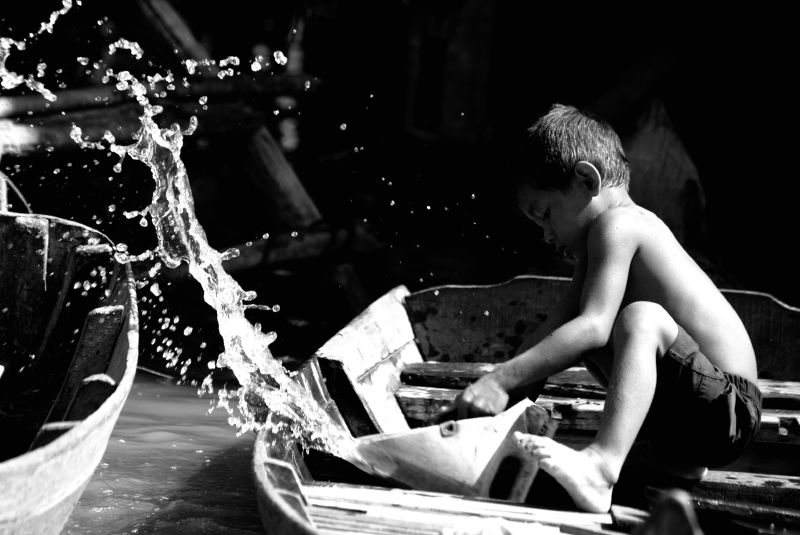នៅប្រទេសកម្ពុជា ការផ្លាស់ប្តូររវាងគ្រោះរាំងស្ងួតនិងគ្រោះទឹកជំនន់នាំមកនូវសេចក្តីប្រឈមសម្រាប់ការគ្រប់គ្រងទឹក។និន្នាការបច្ចុប្បន្នបង្ហាញថា មានកំណើនចំពោះភ្លៀងធ្លាក់ប្រចាំឆ្នាំនិងសីតុណ្ហភាពនៅទូទាំងប្រទេសកម្ពុជា ដែលអាចនឹងមានការកើនឡើងនៃភាពញឹកញាប់(ប្រេកង់) កម្រិតធ្ងន់ធ្ងរនិងរយៈពេលកើតមាននៃគ្រោះរាំងស្ងួតនិងគ្រោះទឹកជំនន់។1ការគ្រប់គ្រងទឹករួមបញ្ចូលបញ្ហាមួយចំនួនដូចជា ការអភិវឌ្ឍសេដ្ឋកិច្ច សន្តិសុខស្បៀងអាហារ និងកត្តាអនាម័យ និងមានទំនាក់ទំនងជិតស្និទ្ធិជាមួយនឹង ការគ្រប់គ្រងគ្រោះមហន្តរាយនិងផែនការនៃការផ្លាស់ប្តូរអាកាសធាតុ។

កុមារបាចទឹកចេញពីទូកនៅកម្ពុជា។ រូបភាពថតដោយ Edwin Lee នៅថ្ងៃទី ០៨ ខែធ្នូ ឆ្នាំ២០០៨។ ក្រោមអាជ្ញាប័ណ្ណ៖ CC BY-SA 2.0
ខណៈពេលដែលអាកាសធាតុមានបម្រែបម្រួលខ្លាំងនិងការផ្លាស់ប្តូរអាកាសធាតុបានគម្រាមកំហែងដល់ការគ្រប់គ្រងទឹក គម្រោងសាងសង់ធំៗមួយចំនួន តួរយ៉ាងគម្រោងទំនប់វារីអគ្គិសនីនៅក្នុងប្រទេសកម្ពុជានិងនៅបណ្តាប្រទេសជិតខាងបានផ្តល់ការគម្រោមកំហែងភ្លាមៗលឿនជាងកត្តាពីធម្មជាតិ។2
ការអភិវឌ្ឍហេដ្ឋារចនាសម្ព័ន្ធទឹក គោលនយោបាយនិងការគ្រប់គ្រងទឹកមានលក្ខណៈសំខាន់សម្រាប់ប្រទេសកម្ពុជា ជាពិសេសក្នុងការធានាឱ្យបាននូវទឹកស្អាតសម្រាប់ការប្រើប្រាស់ និងកត្តាអនាម័យ ក៏ដូចជាប្រភពទឹកសម្រាប់ការស្រោចស្រព។
ប្រភពទឹកជាសម្បត្តិរបស់រដ្ឋ3 ដែលរដ្ឋាភិបាលមានភារកិច្ចក្នុងការគ្រប់គ្រងតាមរយៈក្រសួងនិងអាជ្ញាធរនៅទូទាំងប្រទេស។ ជនគ្រប់រូបអាចប្រើប្រាស់ប្រភពទឹកសម្រាប់តម្រូវការប្រចាំថ្ងៃនិងការស្រោចស្រោបក្នុងមូលដ្ឋាន។ ប្រភេទនៃការប្រើប្រាស់ផ្សេងទៀតតម្រូវឱ្យមានអាជ្ញាប័ណ្ណ។ មានអនុក្រឹត្យស្តីអំពីបញ្ហានេះកំពុងត្រូវបានព្រាងឡើង។
ឯកសារច្បាប់គត្តិយុត្តិចម្បងសម្រាប់ការគ្រប់គ្រងទឹកសំដៅលើច្បាប់ឆ្នាំ២០០៧ស្តីអំពីទឹក ដែលរួមមានក្រមខណ្ឌគតិយុត្តិនៃគោលនយោបាយនិងការគ្រប់គ្រងទឹក។
ក្របខណ្ឌគតិយុត្តិ និងក្របខណ្ឌរដ្ឋបាល
ការគ្រប់គ្រងទឹកគឺជាបន្ទុករបស់រដ្ឋាភិបាលតាំងពីមុនពេលដែលច្បាប់ពាក់ព័ន្ធត្រូវបានអនុម័ត។ គោលនយោបាយដែលបានអនុម័តក្នុងរយៈពេលប៉ុន្មានទសវត្សនេះបង្ហាញថាការគ្រប់គ្រងទឹកជានិច្ចកាលជាផ្នែកមួយនៃគោលនយោបាយទូលំទូលាយជាងនេះ ដែលពាក់ព័ន្ធនឹងការអភិវឌ្ឍសេដ្ឋកិច្ច គ្រោះធម្មជាតិ កតា្តអនាម័យប្រសើរជាងមុន និងការផ្លាស់ប្តូរអាកាសធាតុដែលកើតមានឡើងក្នុងពេលថ្មីៗនេះ។ គម្រោងសំខាន់ពីរក្នុងរចនាសម្ព័ន្ធរដ្ឋាភិបាលគឺយុទ្ធសាស្ត្រចតុកោណដំណាក់កាលទី០៣និងផែនការអភិវឌ្ឍថ្នាក់ជាតិ ក្នុងកញ្ចប់ថវិការចំនួន ២៦.៥៩ពាន់លានដុល្លារ។4
| គ្រោះធម្មជាតិ/ កសិកម្ម/ ការផ្លាស់ប្តូរអាកាសធាតុ | ការគ្រប់គ្រងទឹក |
ផែនការសកម្មភាពថ្នាក់ជាតិសម្រាប់កាត់បន្ថយគ្រោះមហន្តរាយ ២០០៨-២០១៣ (អង់គ្លេស) ក្រសួងផែនការ | ច្បាប់ស្តីអំពីការការពារបរិស្ថាននិងការគ្រប់គ្រងធនធានធម្មជាតិ ១៩៩៦ (អង់គ្លេស) ក្រសួងបរិស្ថាន |
ផែនការយុទ្ធសាស្ត្រថ្នាក់ជាតិសម្រាប់ការអភិវឌ្ឍបៃតង ២០១៣-២០៣០ (អង់គ្លេស) ក្រសួងបរិស្ថាន | អនុក្រឹត្យលេខ ២៧ ស្តីអំពីការគ្រប់គ្រងកង្វះទឹក ១៩៩៩ ក្រសួងធនធានទឹកនិងឧតុនិយម |
ផែនការយុទ្ធសាស្ត្រសម្រាប់បម្រែបម្រួលអាកាសធាតុ ២០១៤-២០២៣ (អង់គ្លេស) ក្រសួងបរិស្ថាន | ច្បាប់ស្តីអំពីការគ្រប់គ្រងទឹក ២០០៧ (អង់គ្លេស) ក្រសួងធនធានទឹកនិងឧតុនិយម |
ផែនការយុទ្ធសាស្ត្រអភិវឌ្ឍថ្នាក់ជាតិ ២០១៤-២០១៨ ក្រសួងផែនការ | យុទ្ធសាស្ត្រថ្នាក់ជាតិស្តីពីការផ្គត់ផ្គង់ទឹកតាមជនបទ និងអនាម័យ ២០១១-២០២៥ (អង់គ្លេស) ក្រសួងអភិវឌ្ឍជនបទ |
យុទ្ធសាស្ត្រចតុកោណអាណាត្តិទី ០៣ ២០១៥-២០១៨ (អង់គ្លេស) រាជរដ្ឋាភិបាលកម្ពុជា | អនុក្រឹត្យគាំទ្រច្បាប់ ២០០៧ (ក្រសួងធនធានទឹកនិងឧតុនិយម, ២០១៥ – ?)5 |
ក្រសួងមួយចំនួនបានបង្កើតគម្រោងផ្ទាល់ខ្លួន ដោយបានកំណត់យកកម្មវត្ថុជាច្រើនសម្រាប់ការអភិវឌ្ឍរបស់ប្រទេសកម្ពុជា។ កិច្ចសហប្រតិបត្តិការអន្តរក្រសួងត្រូវបានតម្រូវខណៈពេលមានចំណុចផ្ទួនគ្នានៃគម្រោងនីមួយៗ ដែលគម្រោងទាំងនេះមានគោលបំណងក្នុងការផ្តល់សន្តិសុខទឹកនិងសន្តិសុខស្បៀងអាហារ។ ទំនាក់ទំនងអន្តកាល រវាងដី ទឹកនិងកសិកម្មបានផ្តល់ផលលំបាកកាន់តែខ្លាំងក្នុងការគ្រប់គ្រងរវាងក្រសួងពាក់ព័ន្ធ។ គម្រោងខ្លះត្រូវបានទ្រទ្រង់ដោយកសិប្រពលវប្បកម្ម ដែលអាចនឹងមានផលប៉ះពាល់ទៅកាន់កត្តាផ្សេងៗទៀតដោយផ្ទាល់ ឬដោយប្រយោល។
ក្រសួងនិងអាជ្ញាធរមួយចំនួនមានភារកិច្ចទទួលខុសត្រូវលើការគ្រប់គ្រងទឹក ដោយក្រសួងធនធានទឹកនិងឧតុនិយមមានតួរនាទីចម្បងក្នុងបញ្ហានេះ។
ក្រសួងពាក់ព័ន្ធរួមមាន៖
- ក្រសួងរ៉ែនិងថាមពល ទទួលបន្ទុកផ្តល់ការផ្គត់ផ្គង់ទឹកទៅកាន់ទីក្រុងនិងស្រុកក្នុងខេត្តនានា។ ក្រសួងនេះក៏ទទួលបន្ទុកចំពោះកត្តាវារីអគ្គីសនីផងដែរ។
- ក្រសួងអភិវឌ្ឍជនបទ ទទួលបន្ទុកផ្តល់ការផ្គត់ផ្គង់ទឹក អនាម័យនិងប្រព័ន្ធលូក្នុងដីនៅតាមទីជនបទ។
- ក្រសួងសាធារណការនិងដឹកជញ្ជូនទទួលបន្ទុកផ្តល់ការផ្គត់ផ្គង់ទឹកនិងអនាម័យក្នុងរាជធានីភ្នំពេញ ជាមួយអាជ្ញាធរទឹកស្អាត។
- ក្រសួងបរិស្ថានទទូលបន្ទុកគាំពារធនធានទឹក។
- ក្រសួងកសិកម្ម កសិកម្ម រុក្ខប្រមាញ់និងនេសាទ ទទួលបន្ទុកអនុម័តគោលនយោបាយនិងការអនុវត្តសម្រាប់ប្រព័ន្ធស្រោចស្រោបនិងអាងស្តុកទឹក ទាំងក្នុងតំបន់ព្រៃនិងតំបន់ជលផល។
- ក្រសួងផែនការទទួលបន្ទុករៀបចំផែនការ។
- ក្រសួងសុខាភិបាលទទួលបន្ទុកគ្រប់គ្រងគុណភាពទឹកសម្រាប់ប្រព័ន្ធទឹកសាធារណៈ។
- ក្រសួងហិរញ្ញវត្ថុទទួលបន្ទុកសម្របសម្រួលការស្នើរឡើងនានាទាក់ទងនឹងការគ្រប់គ្រងទឹក ខណៈពេលបំពេញទៅតាមចំនុចអាទិភាពរបស់រដ្ឋាភិបាល។
សរុបមក មានក្រសួងមិនតិចជាង៩ទេដែលទទួលបន្ទុកដោយផ្ទាល់ឬដោយប្រយោលក្នុងការគ្រប់គ្រងទឹកនៅក្នុងប្រទេសកម្ពុជា។6
ទន្ទឹមនឹងនេះ មានការបំពេញបន្ថែមពីស្ថាប័នរដ្ឋាភិបាលនានា ដូចជាគណៈកម្មាការអន្តរកាលនិងភ្នាក់ងារផ្សេងៗ ដែលក្នុងនោះមានទំនាក់ទំនងខ្លាំងជាងគេគឺក្រុមប្រឹក្សាថ្នាក់ជាតិសម្រាប់ការអភិវឌ្ឍប្រកបដោយនិរន្តរភាព ដែលជំនួសលើអតីតគណៈកម្មាធិការជាតិស្តីពីការផ្លាស់ប្តូរអាកាសធាតុនិងក្រុមប្រឹក្សាថ្នាក់ជាតិសម្រាប់ការអភិវឌ្ឍបៃតង)។ ផែនការពាក់ព័ន្ធអាចរកបាននៅទីនេះ។
ទឹកក៏ត្រូវបានគ្រប់គ្រងនៅថ្នាក់មូលដ្ឋានផងដែរ៖
- នៅថ្នាក់ខេត្តឬសាលាខេត្ត ដែលរួមមានគណៈកម្មាធិការថ្នាក់ខេត្ត និងគណៈកម្មាធិការគ្រប់គ្រងគ្រោះមហន្តរាយថ្នាក់ខេត្ត(PDMC), ដែលស្ថិតក្រោមការគ្រប់គ្រងរបស់អភិបាលខេត្ត។គណៈកម្មាធិការគ្រប់គ្រងគ្រោះមហន្តរាយថ្នាក់ខេត្ត(PDMC)គ្រប់គ្រងការឆ្លើយតប ភ្លាមៗដើម្បីជួយដល់សហគមក្នុងមូលដ្ឋាន រួមមានការបូមទឹកជំនន់ឬការចែកចាយគ្រាប់ពូជ។
- ថ្នាក់ស្រុក ទទួលបន្ទុកផ្តល់នូវព័ត៌មានជាច្រើនស្តីអំពីគ្រោះមន្តរាយដែលប្រមូលបានពីអ្នកភូមិនិងអាជ្ញាធរថ្នាក់ឃុំ។អាជ្ញាធរនេះបានដើរតួនាទីជាមធ្យោបាយក្នុងការផ្សារភ្ជាប់ព័ត៌មានរវាងថ្នាក់ខេត្តនិងថ្នាក់ឃុំ។
- ថ្នាក់ឃុំ ទទួលបន្ទុករៀបចំរបាយការណ៍ប្រចាំឆ្នាំស្តីអំពីការអភិវឌ្ឍនិងការវិនិយោគ។ តួនាទីចម្បងរបស់ស្ថាប័ននេះជាជំនួយដល់គោលនយោបាយថ្នាក់ជាតិ តំណាងឱ្យរដ្ឋាភិបាលនិងដោះស្រាយតម្រូវការចាំបាច់របស់ថ្នាក់មូលដ្ឋាន។
- ថ្នាក់ភូមិ ទទួលបន្ទុកក្នុងការសម្របសម្រួលយុទ្ធនាការរបស់ថ្នាក់មូលដ្ឋាននិងទទួលបន្ទុកក្នុងគម្រោងប្រកាសអាសន្ន។ តួនាទីរបស់ពួកគេមានសារៈសំខាន់ក្នុងការឆ្លើយតបគ្រោះមហន្តរាយ។ ពួកគេក៏បានផ្តល់មន្ត្រីទទួលបន្ទុកការងារប្រកាសអាសន្នឱ្យជួយជម្លៀសអ្នកស្រុក រៀបចំយុទ្ធនាការសង្គ្រោះក្នុងអំឡុងពេលគ្រោះទឹកជំនន់និងជួយសម្របសម្រួលដល់ការចែកចាយនូវសម្ភារៈសង្គ្រោះបន្ទាន់ផងដែរ។
គោលនយោបាយនិងយុទ្ធសាស្ត្ររបស់រាជរដ្ឋាភិបាល
គោលនយោបាយទឹកបានចាប់ផ្តើមក្នុងកម្រិតថ្នាក់តំបន់។ ក្នុងឆ្នាំ១៩៩៥ កិច្ចព្រមព្រៀងលើការអភិវឌ្ឍប្រកបដោយនិរន្តរភាពក្នុងតំបន់អាងទន្លេមេគង្គ ដែលត្រូវបានបង្កើតឡើងដោយគណៈកម្មាធិការទន្លេមេគង្គ ត្រូវបានចុះហត្ថលេខាដោយបណ្តាប្រទេសជិតខាងរបស់កម្ពុជា។ នេះជាកិច្ចបន្ទាប់ពីផែនការអភិវឌ្ឍថ្នាក់ជាតិ ឆ្នាំ ២០០៦-២០១០ 7 ដែលរួមមានខ្លឹមសារជាច្រើនដែលទាក់ទងនឹងទឹក។ ច្បាប់ស្តីពីការគ្រប់គ្រងធនធានទឹកត្រូវបានបង្កើតឡើងក្នុងឆ្នាំ២០០៧។
កម្មវត្ថុរបស់ច្បាប់នេះគឺបង្កើនដីកសិកម្មដែលទទួលបានការស្រោចស្រោប ក៏ដូចជានាំយកវិនិយោគទុនទៅកាន់វិស័យទឹក។ ច្បាប់នេះក៏បានកំណត់អំពីសិទ្ធិនិងភារកិច្ចរបស់អ្នកប្រើប្រាស់ទឹក គោលការណ៍នៃការគ្រប់គ្រងធនធាននិងការចូលរួមរបស់អ្នកប្រើប្រាស់ក្នុងការអភិវឌ្ឍធនធានទឹក។8
ក្រសួងធនធានទឹកនិងឧតុនិយមទទួលបន្ទុកក្នុងការកំណត់គោលនយោបាយនិងយុទ្ធសាស្ត្រអភិវឌ្ឍ ក៏ដូចជាធ្វើការស្រាវជ្រាវនិងការស៊ើបអង្កេត។ ក្រសួងនេះក៏ទទួលបន្ទុកក្នុងការគ្រប់គ្រងគ្រោះទឹកជំនន់និងគ្រោះរាំងស្ងួត ក៏ដូចជាចាត់វិធានការជាមួយក្រសួងពាក់ព័ន្ធនិងអាជ្ញាធរដែនដីផងដែរ។
ការគ្រប់គ្រងធនធានទឹកចម្រុះ (IWRM) គឺជាវិធីសាស្ត្រចម្បងសម្រាប់ការអនុវត្តច្បាប់នេះ។ក្រសួងធនធានទឹកនិងឧតុនិយមរៀបចំបញ្ជីសារពើភ័ណ្ឌដែលកំណត់អំពីទីតាំង ចំនួននិងគុណភាពនៃធនធាន។ ការប្រមូលទិន្នន័យត្រូវបានបញ្ជូនទៅកាន់ក្រសួងនិងត្រូវតែផ្តល់ទៅកាន់សាធារណៈជនដោយសេរី។9ក្រសួងធនធានទឹកនិងឧតុនិយមផ្តល់អាជ្ញាប័ណ្ណនិងការអនុញាតិសម្រាប់ការប្រើប្រាស់ទឹក។ ក្រសួងដដែលបានរៀបចំអនុក្រឹត្យចំនួន៤ដើម្បីជាជំនួយដល់ច្បាប់នេះ៖
- អនុក្រឹត្យលេខ ៧៣ ស្តីអំពីដំណើរការនៃការបង្កើតសហគមនេសាទ អនុម័តនៅថ្ងៃទី៣០ ខែមិថុនា ២០០៨)
- អនុក្រឹត្យស្តីពីការគ្រប់គ្រងអាងទន្លេ (អនុម័តនៅថ្ងៃទី១២ ខែមីនា ឆ្នាំ២០១៥)
- អនុក្រឹត្យស្តីអំពីការគ្រប់គ្រងទឹកនិងអាជ្ញាប័ណ្ណ (ស្ថិតក្នុងពង្រាង)
- អនុក្រឹត្យស្តីពីគុណភាពទឹក (ស្ថិតក្នុងពង្រាង)
- អនុក្រឹត្យទីប្រាំស្តីអំពីទឹក្រោមដីត្រូវបានកត់សម្គាល់ដោយក្រសួង។10
នៅឆ្នាំ២០០៣ រដ្ឋាភិបាលបានកំណត់គោលនយោបាយវិស័យអនាម័យនិងការផ្គត់ផ្គង់ទឹកថ្នាក់ជាតិជាមួយនឹងទស្សនវិស័យដែលគ្រប់គ្រងលើវិស័យនេះទាំងមូលត្រឹមឆ្នាំ២០២៥។យុទ្ធសាស្ត្រទឹកប្រើប្រាស់ជនបទ និងអនាម័យ ២០១០-២០២៥ ក៏ត្រូវបានបង្កើតផងដែរក្នុងឆ្នាំ២០១០។
គោលបំណងនៃយុទ្ធសាស្ត្រស្ថិតត្រង់ការកំណត់ការផ្គត់ផ្គង់ទឹក សេវាអនាម័យដែលអាចផ្តល់ទៅប្រជាជនដែលរស់នៅតាមជនបទនិងរៀបចំហេដ្ឋារចនាសម្ព័ន្ធ ក៏ដូចជាធនធានហិរញ្ញវត្ថុ ធនធានមនុស្សនិងធនធានដ៏ទៃទៀតដែលចាំបាច់សម្រាប់ការផ្តល់សេវាទាំងនេះប្រកបដោយនិរន្តភាព។ គោលបំណងមួយក្នុងចំណោមនោះគឺជាជំនួយក្នុងការពន្លឿនដំណើរការនេះដើម្បីឆ្ពោះទៅកាន់ការសម្រេចបាននូវចក្ខុវិស័យសម្រាប់វិស័យនេះក្នុងឆ្នាំ២០២៥។
យុទ្ធសាស្ត្រថា្នក់ជាតិសម្រាប់វិស័យកសិកម្មនិងទឹក (SAW) ផ្តោតទៅលើវិនិយោគទុននិងប្រព័ន្ធស្រោចស្រោប ពិសេសហេដ្ឋារចនាសម្ព័ន្ធខ្នាតធំ ដែលជានិច្ចកាលត្រូវបានអនុវត្តក្រោមជំនួយពីដៃគូខាងក្រៅ ដែលជាកិច្ចបន្ថែមទៅលើការអភិវឌ្ឍនៃគម្រោងថ្មី ដែលការងារច្រើននឹងផ្តោតទៅលើការកែតម្រូវនៃគម្រោងដែលមានរួចជាសេ្រច។
ឯកសារច្បាប់ចម្បងសម្រាប់ប្រព័ន្ធធារាសាស្ត្រគឺគោលនយោបាយអនុវត្តសម្រាប់ប្រព័ន្ធធារាសាស្ត្រប្រកបដោយនិរន្តរភាព(១៩៩៩)។ ឯកសារនេះទទួលស្គាល់សហគមន៍កសិករប្រើប្រាស់ទឹកថាជាស្ថាប័នស្របច្បាប់ទទួលបន្ទុកការគ្រប់គ្រងប្រចាំថ្ងៃនៃគម្រោងស្រោចស្រោប។ នេះរួមបញ្ចូលទាំងសោធទនកម្មច្បាប់ដែលអះអាងថា៖ ប្រព័ន្ធធារាសាស្ត្រដែលអាចបង្កើតឡើងបានលុះត្រាមានការអនុញាតិពីសហគមន៍កសិករប្រើប្រាស់ទឹក។ ក្រសួងធនធានទឹកនិងឧតុនិយមទទួលបន្ទុកផ្តល់ជំនួយបចេ្ចកទេស។ អ្នកអង្កេតការណ៍ជាច្រើន រួមមានធនាគារអភិវឌ្ឍអាស៊ី យល់ឃើញថា ប្រព័ន្ធនេះមិនទាន់ដំណើរការបានយ៉ាងមានប្រសិទ្ធភាពនោះទេ។11
ក្រៅពីគោលនយោបាយរបស់រដ្ឋាភិបាល គោលដៅសំខាន់សម្រាប់គោលនយោបាយនេះគឺ សម្រេចឱ្យបាននូវគោលដៅទី៣ដែលបានកំណត់ក្នុងគោលដៅអភិវឌ្ឍន៍សហសវត្សរ៍ទី០៧៖ កាត់បន្ថយចំនួនប្រជាជនដែលមិនទទួលបានទឹកប្រើប្រាស់និងអនាម័យត្រឹមឆ្នាំ២០១៥។ ខណៈពេលដែលអង្គការ UNICEF បានលើកឡើងថា កំណើននៃការទទួលបានទឹកប្រើប្រាស់និងអនាម័យសម្រាប់ប្រជាជនទីទ័លក្រមានផលប៉ះពាល់ចម្បងបំផុតទៅកាន់ការកាត់បន្ថយភាពក្រីក្រ សមភាពយែនឌ័រ សុខាភិបាលនិងវិស័យអប់រំ។12
ក្រសួងអភិវឌ្ឍជនបទបានឱ្យដឹងថា ប្រទេសកម្ពុជាបានសម្រេចគោលដៅនេះកាលពីឆ្នាំមុនដោយពាក់កណ្តាលនៃតំបន់នៅតាមទីជនបទអាចទទួលបានទឹកស្អាតប្រើប្រាស់រួចហើយក្នុងពេលបច្ចុប្បន្ន។ ក្រសួងដដែលក៏បាននិយាយផងដែរថា នៅដើមឆ្នាំ២០១៦ ៤៦ភាគរយនៃប្រជាជននៅតាមទីជនបទមានបង្គន់ប្រើប្រាស់ និងទទួលបានបរិក្ខារសម្រាប់ការលាងសំអាតដៃនិងអនាម័យ។13
ចំណុចប្រឈមនិងទស្សនវិស័យទៅថ្ងៃអនាគត
គោលនយោបាយរបស់រដ្ឋាភិបាលស្តីអំពីកំណើននៃទិន្នផលស្រូវអង្ករនាំឱ្យមានការទិញយកដីក្នុងទ្រង់ទ្រាយធំសម្រាប់ការធ្វើកសិកម្មតាមកិច្ចសន្យា។ កត្តានេះនាំឱ្យមានការធ្វើពាណិជ្ជនីយកម្មកាន់តែច្រើននៃទឹកដែលបង្កើតជាសេចក្តីប្រឈមចំពោះការប្រើប្រាស់តាមផ្ទះនិងកសិដ្ឋានតូចៗ។ ទោះបីជាគោលនយោបាយនេះមិនទាន់បានអនុវត្តពេញលេញក៏ដោយ ការធ្វើកសិកម្មតាមកិច្ចសន្យាគឺជាផ្នែកមួយយ៉ាងសំខាន់សម្រាប់ការគ្រប់គ្រងទឹក។14យ៉ាងណាមិញ គម្រោងអភិវឌ្ឍនៅតែផ្តោតលើការនាំចេញស្រូវអង្ករ ដែលទាមទារឱ្យមានហេដ្ឋារចនាសម្ព័ន្ធធារាសាស្ត្រកាន់តែទូលំទូលាយ។ ចំណុចប្រឈមស្ថិតនៅត្រង់ការស្វែងរកវិធីសាស្ត្រក្នុងការប្រើប្រាស់ទឹកដើម្បីជាជំនួយដល់ការអភិវឌ្ឍសេដ្ឋកិច្ចខណៈទ្រទ្រង់ការកាត់បន្ថយភាពក្រីក្រតាមរយៈសន្តិសុខស្បៀងអាហារនិងអនាម័យនៅថ្នាក់មូលដ្ឋាន។ មានចំណុចប្រឈមសម្រាប់បញ្ហាបច្ចេកទេសក្នុងការអភិវឌ្ឍធនធានទឹកនៅក្នុងតំបន់ដែលទឹកក្រោមដីត្រូវបានបំពុលដោយសារធាតុអាសេនិច។
ធ្វើបច្ចុប្បន្នភាពចុងក្រោយ៖ ថ្ងៃទី២០ ខែកក្កដា ឆ្នាំ២០១៦
ទាក់ទងនឹងគោលនយោបាយនិងការគ្រប់គ្រងទឹក
- ធនធានទឹក
- គ្រោះមហន្តរាយ និងការឆ្លើយតបក្នុងគ្រាអាសន្ន
- ការប្រែប្រួលអាកាសធាតុ
- ទិដ្ឋភាពទូទៅនៃគោលនយោបាយ និងក្របខណ្ឌច្បាប់
- ការបំពុលទឹក
ឯកសារយោង
- 1. ហេង ចាន់ធឿន (២០១៥). “ការត្រួតពិនិត្យនិងការប៉ានស្មាននៃបំលាស់ប្តូរសីតុណ្ហភាពនិងភ្លៀងធ្លាក់នៅប្រទេសកម្ពុជា”. អាកាសធាតុនិងធាតុអាកាសមានបម្រែបម្រួលខ្លាំង, SI: IGBP APN.ចូលអានថ្ងៃទី ៣០ មិថុនា ២០១៦. http://www.sciencedirect.com/science/article/pii/S2212094715000043
- 2. Marko Keskinen, Paradis Someth, Aura Salmivaara, Matti Kummu(២០១៥). ទំនាក់ទំនងរវាង ទឹក-ថាមពល-អាហារ ក្នុងអាងទន្លេឆ្លងព្រំដែន៖ ករណីទន្លេសាប.អាងទន្លេមេគង្គ, ក្រុមទឹកនិងការស្រាវជ្រាវអភិវឌ្ឍន៍, សាកលវិទ្យាល័យ Aalto, នាយកដ្ឋានវិស្វកម្មជនបទ, វិទ្យាស្ថានបច្ចេកវិទ្យាកម្ពុជា.ចូលអានថ្ងៃទី ៣០ មិថុនា ២០១៦.http://www.mdpi.com/2073-4441/7/10/5416
- 3. ច្បាប់ស្តីពីការគ្រប់គ្រងធនធានទឹក, មាត្រា០១.http://www.cambodiainvestment.gov.kh/law-on-water-resource-management-full-text_070629.html
- 4. សាម ស្រីម៉ុម, ពេជ្រ សុខឃឹម (២០១៥). “ការផ្លាស់ប្តូរអាកាសធាតុនិងការគ្រប់គ្រងទឹកនៅកម្ពុជា៖ ចំណុចប្រឈមនិងទស្សនៈវិស័យទៅលើសន្តិសុខទឹកនិងការផ្លាស់ប្តូរអាកាសធាតុ ក្នុងកន្លែងស្តុកទឹកដែលបានជ្រើសរើស, ប្រទេសកម្ពុជា. វិទ្យាស្ថានដើម្បីបណ្តុះបណ្តាលនិងស្រាវជ្រាវដើម្បីអភិវឌ្ឍកម្ពុជា(CDRI). ចូលអានថ្ងៃទី ៣០ មិថុនា ២០១៦. http://www.cdri.org.kh/webdata/download/sr/ccwg-e.pdf
- 5. ធនាគារអភិវឌ្ឍអាស៊ី. “កម្ពុជា៖ កម្មវិធីអភិវឌ្ឍនិងគ្រប់គ្រងវិស័យធនធានទឹក”. ចូលអានថ្ងៃទី ០២ កក្កដា ២០១៦. http://www.adb.org/projects/38558-013/main
- 6. កម្មវិធីអភិវឌ្ឍសមត្ថភាពស្រាវជ្រាវសម្រាប់ការគ្រប់គ្រងធនធានទឹក(WRMRCDP) (២០១០). ភស្តុតាងយ៉ាងសំខាន់សម្រាប់ការគ្រប់គ្រងប្រព័ន្ធស្រោចស្រោបក្នុងអាងទន្លេសាប៖ បញ្ហានិងកត្តាប្រឈម”. ចូលអានថ្ងៃទី ០២ ខែកក្កដា ឆ្នាំ២០១៦. http://www.cdri.org.kh/webdata/download/wp/wp48e.pdf
- 7. S. Turner, G. Pangare, R.J. Mather (២០០៩). “រដ្ឋបាលទឹក៖ ការវិភាគទៅលើស្ថានភាពមួយក្នុងប្រទេសកម្ពុជា សាធារដ្ឋឡាវនិងប្រទេសវៀតណាម. កិច្ចសន្ទនាទឹកក្នុងតំបន់មេគង្គ”. ចូលអាន ២៧ មិថុនា ២០១៦.https://www.iucn.org/sites/dev/files/import/downloads/water_governance_a_situational_analysis.pdf
- 8. ច្បាប់លើការគ្រប់គ្រងធនធានទឹក មាត្រា០១. http://www.cambodiainvestment.gov.kh/law-on-water-resource-management-full-text_070629.html
- 9. ច្បាប់លើការគ្រប់គ្រងធនធានទឹក មាត្រា០៨. http://www.cambodiainvestment.gov.kh/law-on-water-resource-management-full-text_070629.html
- 10. ហាក់ម៉ៅ(២០១៣). សិក្ខាសាលាស្តីអំពី “ការផ្លាស់ប្តូរអាកាសធាតុនិងការគ្រប់គ្រងទឹកក្នុងប្រទេសកម្ពុជា”. ក្រសួងធនធានទឹកនិងឧតុនិយម. ចូលអានថ្ងៃទី ២៧ មិថុនា ២០១៦.http://www.cdri.org.kh/webdata/download/sr/ccwg-e.pdf
- 11. ធនាគារអភិវឌ្ឍអាស៊ី(២០១០). “ កសិកម្មនិងវិស័យអភិវឌ្ឍជនបទនៅកម្ពុជា៖ ការសិក្សា”. ចូលអានថ្ងៃទី ២៩ មិថុនា ឆ្នាំ២០១៦. http://www.adb.org/sites/default/files/evaluation-document/35757/files/lc-sape-agriculture-cam.pdf
- 12. UNICEF, “គម្រោងផ្គត់ផ្គង់ទឹកស្អាតនិងអនាម័យ”. ចូលអានថ្ងៃទី ០១ កក្កដា ២០១៦. http://www.unicef.org/cambodia/8.WASH.pdf
- 13. សែន ដេវីត. “ការទទួលបានទឹកស្អាតនៅទីជនបទកើនដល់៥០%. ការសែត ភ្នំពេញប៉ុស្តិ៍, ២៤ កុម្ភៈ ២០១៦. ចូលអាន ២៦ មិថុនា ២០១៦. http://www.phnompenhpost.com/national/access-clean-water-rural-areas-hits-50
- 14. ម៉ៅ សុភារិទ្ធិ. ក្រសួងកសិកម្ម រុក្ខប្រមាញ់និងនេសាទ(២០១៣). “ការធ្វើកសិកម្មតាមកិច្ចសន្យា”. ចូលអាន ២៦ មិថុនា ២០១៦. http://www.fao.org/fileadmin/user_upload/contract_farming/presentations/Dr%20Mao%20Sopheareth%20-%20MAFF-DAI%20-%20CF%20and%20partnerships%20 ENG[1].pdf

